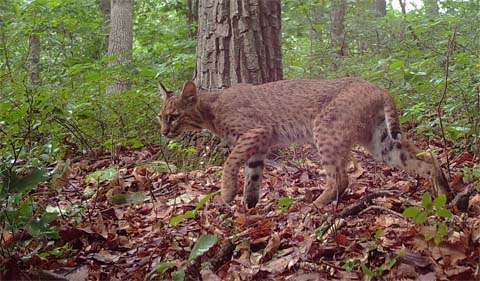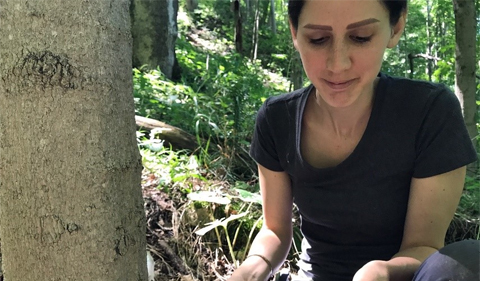From Ohio University News
Up to 6 percent of Ohio’s bobcat population may be killed on roadways each year, say Ohio University researchers in a new study. And getting the felines not to cross busy roads is not an easy mitigation.
Dr. Viorel Popescu and graduate and undergraduate researchers in his lab have spent the last couple of years studying the population of Ohio bobcats – which have been rebounding in numbers – to help inform the state’s wildlife management strategy for the animals.
Popescu has been examining several questions about the Ohio population, including how many bobcats die on Ohio roadways, which have the fifth largest traffic volume in the United States.
In a recent study published in the journal Scientific Reports, Popescu and alumna Heidi Bencin describe using data collected by the Ohio Department of Natural Resources and estimating that a minimum of 6 percent of the bobcat population – but potentially double that or more – may be killed on roads annually. While the range of these estimates is wide, studies in other states have made similar findings, Popescu noted.
Bencin earned an M.S. in Biological Sciences from the College of Arts & Sciences at OHIO in 2019.
As there is no hunting or trapping of bobcats allowed in the state, vehicle strikes are the primary cause of death for the animals, which are top predators in their ecosystem, said Popescu, Assistant Professor of Biological Sciences.
“Road kills are the most important source of mortality in Ohio. Anything we do in terms of projecting the population trajectory into the future has to account for this,” he said.
- This study was also reported in the Athens Messenger in a story headlined “OU scientists publish study on bobcat roadway mortality.”
‘8 to 9 Percent Chance of Getting Killed When Crossing the Interstate Once’
Bencin, Popescu and collaborators looked at various types of roads, from busy interstates and city streets to less congested township and county roads. The research showed that major highways, such as Interstates 70 and 77, are a top source of bobcat road kills, due to high traffic volumes and more lanes of traffic. Forested areas, the natural habitat for bobcats, adjacent to highways also increased mortality.
“We found that the animals have an 8 to 9 percent chance of getting killed when crossing the interstate once,” Popescu said.
County and city roadways were not sites of high mortality, as bobcats tend to avoid developed areas, according to the study. While the animals cross township roads more frequently, these roads do not contribute significantly to bobcat kills, due to low traffic volume.
In general, however, the study showed that bobcats aren’t averse to traveling across roadways.
“Some animals would cross low-traffic roads 200 times in a given year and survive,” Popescu said.
The scientists used a variety of techniques to study roadway mortality and drew on a unique combination of datasets. They examined a historical dataset from 1978-2017, maintained by the Ohio Department of Natural Resources, which recorded more than 500 bobcat vehicle strikes. Researchers also examined data, collected by the Ohio Department of Natural Resources between 2012 and 2014, from 18 animals that wore GPS tracking devices. Finally, they created simulation models to predict movement and behavior in relation to roads.
Fences Won’t Stop the Cats
Posting animal crossing warning signs at locations where road mortality is the highest might be the most effective way to try to reduce road kills, Popescu said. Fences won’t stop cats, which can easily climb and get around such protective barriers, he explained. An ongoing study in Texas, for example, finds that roadside fences aimed at reducing wildlife-vehicle collisions are no match for the felines. Mitigation techniques, which include fences that funnel animals towards wildlife underpasses or overpasses, are more effective for species that cannot climb so easily, such as bears, deer or coyotes, the scientist noted.
“For wide-ranging carnivores in road-dense areas, mitigating road kills is notoriously difficult,” Popescu said. “The roadway engineering options are quite limited.”
Popescu’s lab is continuing to study other aspects of the bobcat population through June 2021 with funding from the Ohio Department of Natural Resources. The Ohio University scientists have been partnering with colleagues from The Wilds to conduct genetic analysis of the population through the collection and analysis of bobcat scat. The state also recently asked the scientists to perform necropsies of animals that had been killed on roadways within a 20-county region in southeast Ohio since October 2019. Popescu and doctoral student Marissa Dyck hope to understand what percentage of these bobcats are females or young animals, and determine the overall impact of roadkill on population viability. The goal of the work is to build a bobcat population model that the Ohio Department of Natural Resources can use to make management and conservation decisions for Ohio’s rebounding bobcats.
Contributors to the study included Suzanne Prange, an Ohio University adjunct faculty member and director of the Appalachian Wildlife Research Institute, and Christa Rose of Native Species Support.






















Comments